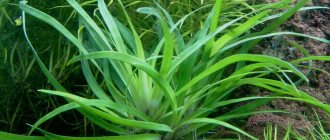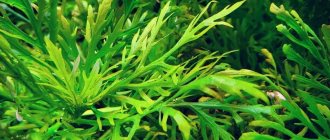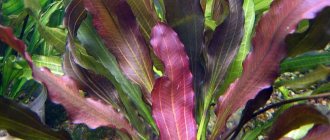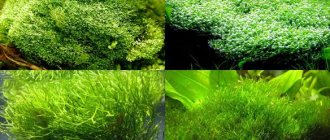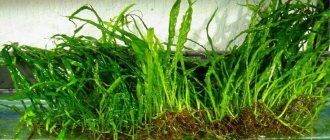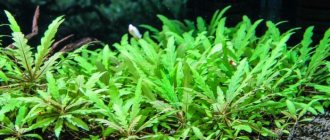An adult plant can reach 60 cm in height. Lanceolate-shaped leaf blades grow up to 40 cm in length. They are attached to thick roots up to 20 cm long and assembled into a rosette. The leaves are olive green on the outside and purple-red on the inside. The leaf surface is smooth and silky.
The rhizome of Barclay longifolia is short and thick, brown in color. Many thin white roots come from it, with the help of which the plant absorbs nutrients from the soil.
Growing and care
Barclaya longifolia is quite demanding in terms of living conditions. Only experienced aquarists can grow it in an artificial environment. It may be difficult for beginners to prevent root rot or maintain hydrochemical parameters within strict limits.
In addition to deviations in water conditions, snails have a negative effect on the plant. If you plan to add a new plant to the Barclay, it is better to first quarantine it in another aquarium to check for diseases and unwanted larvae.
When purchasing Barclay longifolia, you should take into account its characteristics for the correct selection of potential neighbors. For example, plants such as:
- ferns - water, Indian, Thai, Marsilia, Riccia, etc.;
- some weak cryptocorynes;
- a number of rotals and other flowering plants.
- The fact is that adult Barclaya longifolia releases phytoncides into the water - biologically active substances that prevent the growth of lower algae and some higher plants.
- For this reason, many aquarists recommend placing Barclay Longifolia in aquariums with a volume of 150-200 liters so that neighboring plants are not severely damaged.
Water parameters for ideal maintenance
Barclaya longifolia is quite finicky. To grow it comfortably, you will need to strictly adhere to the requirements for the state of the liquid in the aquarium. Recommended hydrochemical parameters:
- temperature - 26-28ºС;
- hardness - 2-4º;
- acid-base balance - 6-7.
If the water temperature drops below the recommended value, the barclay will stop growing and die.
Barclaya longifolia does not require frequent changes of aquarium fluid, since in nature it is found mainly in reservoirs with weak flowing or standing water. Additional aeration may be required if there is too much carbon dioxide in the water. Excess carbon dioxide causes holes to appear in the plant's leaves.
Lighting requirements
Owners of Barclaya longifolia note that the plant does best in moderate light of about 0.7 W/l. Both incandescent and fluorescent lamps can be used as lighting sources.
As experienced aquarists note, to obtain a more saturated color of the leaves of Barclay longifolia, it is better to install combined lighting.
It is worth considering that Barclaya longifolia does not like direct light. Barclay Longifolia is best placed in the shade of Anubias, Echinodorus and other large plants. The optimal daylight hours are 11 hours.
Demanding requirements for soil and nutrient substrate
Since Barclay longifolia has very delicate roots, it is important to choose the right soil in which they will not be damaged. For such purposes, coarse river sand or nutrient substrate with small granules are suitable.
It is desirable that they be porous and light. In an aquarium with Barclaya longifolia, it is enough to lay a layer of soil 5 cm high.
It is recommended to use a substrate with peat as a source of nutrients.
In an aquarium with Barclaya longifolia, you can lay one of these substrates:
- Sera Floredepot. A nutritious substrate of sand and peat will provide the aquarium plants with the necessary nutrients. Placed under a base soil of small pebbles or coarse sand.
- Tetra CompleteSubstrate. Another nutritious substrate that promotes the active growth of aquatic plants. On top it is necessary to lay a layer of “empty” soil 2-3 cm high.
- Tetra ActiveSubstrate. Light, porous soil that can absorb excess nutrients from water and, if necessary, release them back.
- Tropica Plant Growth Substrate. A nutrient support that is also capable of “collecting” excess nutrients. It is enough to lay a layer about 1 cm high under small pebbles. It is a completely neutral substrate and has virtually no effect on hardness and acidity.
Requirement for fertilizers
Since the plant primarily attracts aquarists with its bright leaves, which are completely or partially colored red, it is first necessary to provide Barclay longifolia with sufficient iron. Although other nutrients are no less important for maintaining the healthy growth and development of this capricious representative of aquatic flora.
In a Dutch aquarium, it is recommended to use a complex mineral fertilizer with macro- and microelements. If Barclaya longifolia grows in an aquarium where fish live, it is enough to add only fertilizer with microelements.
Due to the delicate and fragile root system of Barclay longifolia, tablet fertilizers cannot be used. Among the many liquid fertilizers suitable for aquarium plants, the following compositions are popular:
- ADA Green Brighty STEP-2. Liquid fertilizer for daily use. It contains many microelements. Designed to support young aquarium plants in the first months of growth. Additionally contains a large amount of iron.
- Aquayer Iron+. Fertilizer based on iron gluconate. Also a source of manganese.
- Tetra Plant Florapride Red. Liquid nutrition with microelements and chelated iron. Used to provide nutrients to red plants. Reduces the risk of developing algae, does not contain nitrogen and phosphorus.
Lighting
Moderate lighting is most suitable for Barclay. It is better to shade the plant from direct strong light by planting it in the shade of a large Echinodorus, Anubias or other tall plant. For shading, you can also use plants floating on the surface or in the water column. For artificial lighting, fluorescent lamps of the LB type, incandescent lamps or a combination of these lamps are used. It is highly advisable to use incandescent lamps, as in this case the color of the leaves becomes brighter.
Reproduction
When breeding Barclay longifolia, daughter plants can be obtained using seeds or vegetative division.
The last method is the easiest. It is only necessary to separate the young plants that eventually form at the rhizome of the parent bush.
Depending on the growth rate of barclay, division may be required 1-2 times a year. In good conditions, separated daughter plants quickly take root and begin to grow actively.
Much more attention is required from the aquarist who decides to breed Barclaya longifolia using seeds. The plant puts out a peduncle on which a flower blooms on the surface of the water.
The main task is to prevent the seeds from falling to the bottom of the aquarium where the parent plant is located.
To do this, the set fruit must be carefully placed in a thin nylon or nylon bag. After the seeds are collected, they are planted in a container with sandy soil, which is best taken from an old aquarium. The water level in the mini-aquarium should be no more than 3-5 cm. In order for the seeds to hatch, you will need bright diffused light and warm water - no lower than 28-30ºC.
Young plants can be transplanted into a general aquarium after they have formed 5-6 leaves. It is advisable to place them at a distance of at least 20 cm from each other. In closer proximity, Barclay does not grow well.
Videos red barclaya longifolia
It makes sense to separate the baby only after its rosette has 5-6 full-fledged leaves about 10 cm high. You can try earlier, but, based on my own experience, I undertake to say that this is a risky business. And more or less large children do not take root well, but with the “undersized” ones it is simply a disaster. Being a typically tropical plant, Barclaya loves warmth. The minimum temperature for keeping is 20-22°C; at lower temperatures its development stops, the leaves begin to decompose, fall off, and soon the root system is irreversibly destroyed.
Moreover, it needs warmth in the first place, so often in a series of useful tips on keeping Barclay there is the topic of the advisability of bottom heating. Probably, it is completely justified, although my three bushes (and they will soon be two years old) manage well without this attribute.
Variations and forms of the plant
There are several forms of barclay, with both green and red leaves. Their unusual color and appearance make them attractive objects for experienced aquascapers, since such plants help to place accents in the composition. Some can be used to decorate the background of a small aquarium. Let's look at several varieties in more detail.
- Barclaya redifolia. This form is smaller in size compared to the long-leaved one, and its leaves are burgundy-purple in color. The leaf blades grow up to 35 cm in length and up to 3.5 cm in width. All leaves are attached to petioles no more than 5-7 cm long. A feature of red-leaved barclay is the more frequent formation of flowers. It can be planted either in the main aquarium soil of sand or small pebbles, or in a separate pot. This will protect the plant from bottom-dwelling fish that like to dig through the soil.
- Barclaya sp Peruviana. A wine-red plant that looks best surrounded by green neighbors. It has longer leaf cuttings compared to red-leaved barclay - up to 15-25 cm. Leaf blades reach 3 cm in width and up to 30 cm in length. It is an artificially bred form of Barclaya longifolia. It must be taken into account that if the light is too bright, the leaves of the plant lose their decorative wine color and become brown.
Barclaya Peryana. Another form of plant with red leaves. The latter acquire this color due to the content of iron oxides in the tissues of the leaf blade. Moreover, the brightness of the colors increases with increasing lighting. For this reason, Barclay periana must be placed in brightly lit areas, unlike other members of the genus, which prefer at least a little shading. A notable feature of this plant is the ability to produce up to 7 peduncles in one, even small, bush. But you can leave no more than 2-3 stems. Otherwise, the plant will quickly wither.
Barclay longifolia: how to make the underwater world prosperous
When creating an original, harmonious landscape for an aquarium, many today turn to artificial plants: there are fewer worries, and a beautiful appearance is obtained immediately and lasts forever. Those who want to create a living, natural atmosphere on their own should pay attention to a plant such as Barclay longifolia (another name is Barclay longifolia). By creating favorable conditions for it to grow, you will receive a worthy reward for your efforts - a harmonious color composition and lively positive energy.
Lifehacks and tips for aquarists
- Barclay Longifolia does not tolerate silty soil well, so it is advisable to clean the substrate every week. Otherwise, there is a risk of root rotting. In this case, the leaves of Barclaya longifolia separate from the bush and float to the surface. The main thing is to clean carefully so as not to damage the root system of the plant.
- The formation of flowers and subsequent fruits takes a lot of effort from Barclay, which is why the plant often withers after the appearance of the second or third bud. It is advisable to cut them off immediately. As a result, you can get one healthy flower and fruit with seeds.
- Experienced aquarists recommend using clay nutrient soil in the aquarium, which is used for germinating Barclay longifolia seeds. The fact is that there are not many nutrients in the seeds, and for the healthy growth of the seedling, natural fertilizing from the substrate will not be superfluous.
- In order for the plant to feel good in silty soil, it is necessary that the aquarium warms up from the bottom. To do this, you can use waterproof heating pads that can be placed in the ground, or heating pads placed under the bottom of the aquarium. With such a heating system, the soil temperature will always be 2-4 degrees higher than the water temperature. This speeds up metabolic processes in the substrate and prevents organic matter from rotting.
Barclay's Contents
The optimum for barclay is -26-28°C, pH 6.0-6.5, hardness - up to 8°dGH. The water change regime is common for the aquarium and dictated by the needs of its other inhabitants. The plant is indifferent to the presence (or absence) of flow. The lighting is bright but diffuse. However, the moderate power of the lamp (as well as a harsher and more alkaline habitat) is not an obstacle to the normal development of the bush; it will only fade a little, lose the richness of the palette a little, and reduce the rate of vegetation. In my case, a 160-liter aquarium with a height of 40 cm and a bottom area of 100x40 cm is illuminated by four 20-watt fluorescent lamps (one of them with spectral correction). The normal daylight hours are 10-12 hours.
Permissible deviations lie within a fairly wide range: T = 20-32°C, dGH - up to 10-15°, pH - up to 7.0-7.5, minimum duration of daylight time - 6 hours.
But still, Barclay’s conditions should not be taken to extremes. And even more so, one should be wary of sharp fluctuations in hydrochemical parameters, to which this gentle beauty reacts extremely painfully. If you want to make adjustments to the aquarium regime, do it gradually, step by step, giving Barclay time to adapt to the new environment. Otherwise, you can literally lose this luxury in a matter of days. And the first symptom of trouble can be considered a long absence of young leaves. In a “working” rhythm, they are born approximately every two weeks. With the same frequency, a healthy bush sheds old, outdated bushes.
Photo of red longleaf barclay
Longleaf barclay does not require wintering, developing throughout the year. True, this development is uneven: extended periods of pronounced growth alternate with relatively short “lulls”. It is possible that if you give the bush a “vacation” (it is not without reason that some experts in the field of hydrofloristry recommend an annual 1.5-2 month break with reduced light and T = 20-22°C), in the remaining time the rested Barclay longifolia will vegetate more smooth.
In addition to the above-mentioned vegetative method of propagation of Barclay, the seed method is also applicable. This plant reaches sexual maturity by one year. Under favorable conditions of existence, it throws out a bud (or even several), which, growing from the center of the rosette, is either carried to the surface or hangs in the water column. Moreover, seeds are formed in both cases.
It is believed that their germination does not require much trouble: they have good germination, and seedlings have good growth rates and survival rates.
However, this is all theory. I myself prefer not to get involved with the Barclay's heterogeneous reproduction. Firstly, I don’t need a lot of them, and secondly, the seller, from whom I once bought young bushes, warned: after fruiting, the mother plant dies. I don’t know whether this is true or not, but, preferring not to take risks, I mercilessly pinch off the buds as soon as I notice them. So far it helps.
Aquarium Magazine 2009 No. 2
Comments on this article:
Comments added by: Anyuta Date: 2018-05-24
Barclay longifolia, especially the red one, looks very beautiful in the aquarium. I recommend it to everyone.
